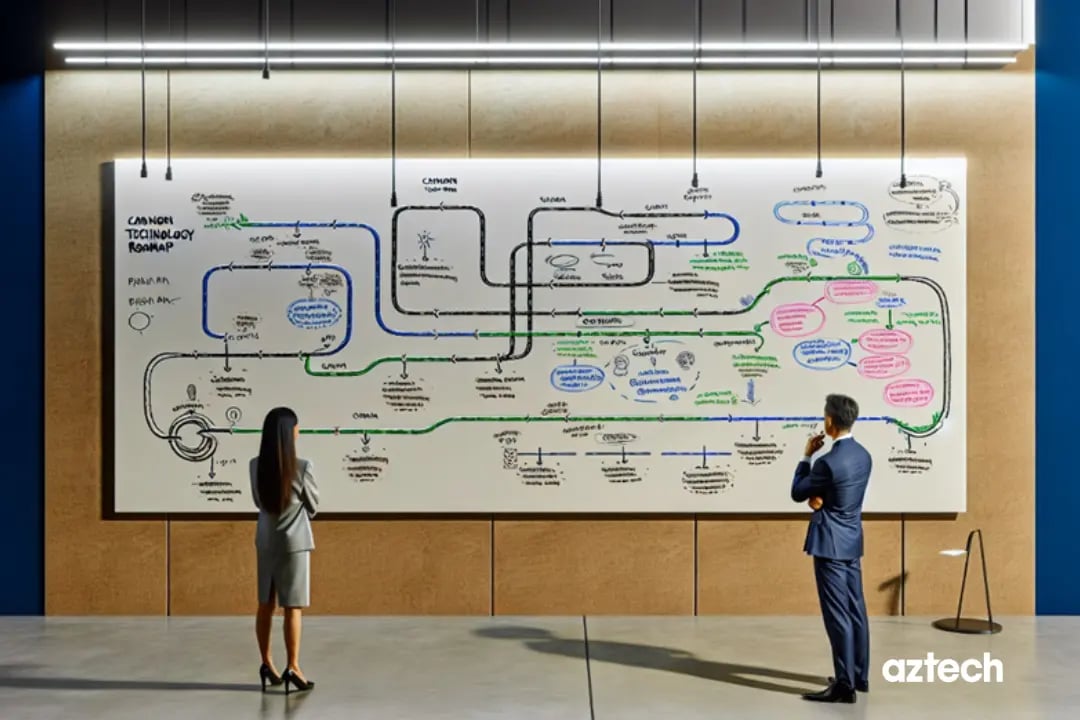Crafting an IT strategy isn’t about embracing technology for the sake of it; it’s about strategically integrating technology to propel your business forward. In practical terms, it means ensuring that every tech decision and investment contributes to your overall business objectives.
This blog post outlines concise steps for aligning your IT strategy with your business goals, enhancing security, and adapting to new technology trends.
Key Takeaways
-
An IT strategy is a comprehensive, long-term plan that aligns technology with business priorities, facilitating competitive advantage by optimising operations, improving customer experiences, and increasing productivity.
-
Effective IT strategies involve key elements such as a clear alignment with business goals, developing an IT roadmap for implementing new technologies and managing risks and security to protect sensitive data and ensure operational continuity.
-
Challenges in developing and implementing an IT strategy can include technical literacy gaps, misaligned KPIs, and a lack of strategic agility, which can impede IT performance and business outcomes.
Understanding IT Strategy
IT strategy is more than just a buzzword; it’s an integral aspect of strategic planning that delineates the appropriate utilisation of technology to achieve IT and business objectives. The role of IT has progressed from merely providing operational support to generating business value. It offers a notable competitive advantage by optimising operations, improving customer experiences, and heightening productivity - all of which are essential for business success.
A robust IT strategy serves as a framework for:
-
Understanding how technology underpins and influences the overarching business strategy of an organisation
-
Fostering operational optimisation, efficiency enhancement, customer experience refinement, and innovation stimulation
-
Aligning the IT strategy with the overarching business strategy and providing support
-
Assisting the IT department in identifying how technology can facilitate the business in attaining its objectives and obtaining a competitive edge
What is IT Strategy (Information Technology Strategy)
An IT strategy is essentially a comprehensive, long-term plan that harmonises technology with business priorities. It functions as a blueprint for technology investments, optimising the returns on these investments, and ensuring technology is in sync with the organisation’s requirements. This strategy encompasses key elements like:
-
Executive summary
-
Current assessment
-
IT vision and goals
-
IT roadmap
-
IT Governance
-
IT organisational structure
-
IT resource plan
-
IT risk management
An IT strategy document serves as a guide for organisations to align their technology investments with their overall business objectives. Together, these components form a structured and strategic method for overseeing a company’s technology.
Implementing an IT strategy calls for strong IT leadership. Key leaders such as the chief information officer (CIO) and chief technology officer (CTO) play crucial roles in working closely with different business departments to ensure the successful execution and alignment of the strategy with the company’s objectives. This alignment is achieved through components like the IT organisational structure and the IT resource plan, which outline the support team structure and plans for managing resources such as personnel and technological assets.
Why Do Businesses Need an IT Strategy?
In the current digital era, an IT strategy is indispensable, not just a luxury, for businesses to stay competitive and relevant. An IT strategy contributes to a business’s competitive advantage by:
-
Assisting in the identification of the latest technology trends
-
Assessing how these trends can be leveraged for competitive advantage
-
Enhancing customer interactions through CRM systems, online portals, and mobile applications, can greatly improve customer experiences.
The IT strategy plan must be in sync with the company’s business vision to effectively boost the overall operational goals. It is crucial for the plan to provide support that complements and advances the company’s objectives. IT initiatives and expenditures must be in line with the company’s goals and mission, as IT cannot operate in isolation from its business partners. Enhancing customer experience can promote customer loyalty and increase revenue, both vital for a business’s ongoing success.
A well-designed IT strategy template can help businesses achieve these goals by incorporating customer experience improvement initiatives.
Key Elements of an Effective IT Strategy

Formulating an effective IT strategy involves certain key metrics. Aligning IT with business strategy goals is of paramount importance as it guarantees that tech investments are directly contributing to the organisation’s objectives, thereby leading to the triumph of the business.
Alongside this, creating an IT roadmap is another vital component. It establishes a structure for the implementation of new technologies and the enhancement of existing systems in a manner that is consistent with strategic IT objectives.
Managing risks and security is another critical factor. As organisations become increasingly dependent on technology, the need for robust security measures to protect sensitive data and ensure operational continuity becomes more significant.
By focusing on these components, businesses can create a solid IT strategy that not only aligns with their business goals but also paves the way for successful digital transformation.
1. Aligning IT with Business Goals
Aligning IT with business goals ensures that technology investments contribute directly to the organisation’s objectives, thus promoting the business goals’ attainment. This alignment is crucial for the triumph of the business as it guarantees that tech investments are directly contributing to the business objectives.
A clear link between IT strategy and business strategy is necessary, encompassing the alignment and focus on overall goals through the mapping of IT objectives and requirements directly to the business objectives.
Integrating IT with business objectives results in heightened revenue, enhanced customer satisfaction, and increased employee productivity. It ensures that IT is aligned with the overall business strategy to guarantee its contribution as a valuable asset in accomplishing business objectives. In essence, aligning IT with business goals is the first step towards developing an IT strategy.
2. Developing a Technology Roadmap

Developing an IT roadmap is an integral part of an IT strategy. It establishes a structure for the implementation of new technologies and the enhancement of existing systems in a manner that is consistent with strategic IT objectives. The process of creating a technology roadmap involves several steps such as:
-
Identifying strategic objectives
-
Determining the roadmap’s audience(s)
-
Establishing major themes
-
Sharing the roadmap with stakeholders
-
Defining goals
-
Assessing current and future trends
-
Gathering stakeholder input
-
Crafting the roadmap
A technology roadmap, with its principal elements like defining the IT systems that enable core capabilities, communicating goals and initiatives, and providing a timeline with details on status and dependencies, is vital for overseeing the company’s information technology.
An effective information technology roadmap can be created by following suggested guidelines such as understanding the ‘why’ behind the roadmap, gathering various viewpoints, defining themes, and organising and prioritising. This roadmap lays the foundation for continuously monitoring IT projects in the future.
3. Managing Risks and Security
The management of risks and security is a critical component of an IT strategy. It safeguards the organisation’s data and infrastructure from potential threats, thereby ensuring operational continuity and the protection of sensitive information. The incorporation of security measures into an IT strategy involves empowering the top security executive, embracing a security-by-design approach, and pinpointing key objectives and vulnerabilities in cybersecurity hygiene.
Security holds significant importance in an IT strategy as it establishes a framework for early threat detection and sets guidelines and protocols to safeguard against cyber threats. Effective risk management in an IT strategy includes:
-
Identifying and assessing risks
-
Regularly updating risk management processes
-
Implementing risk prevention tactics
-
Creating contingency plans
-
Utilising risk mitigation processes
This ensures that comprehensive protection is incorporated into the overall IT strategy.
IT Strategy Examples

IT strategy is not a one-size-fits-all concept. It varies based on the organisation’s specific needs, objectives, and the nature of the business.
Common IT strategy examples include:
-
Digital transformation
-
IT modernisation
-
Cloud migration
-
Security-centric
-
Agile IT strategies
These strategies provide examples of how different organisations leverage technology to achieve their goals and objectives.
Example 1: Digital Transformation Strategy
A digital transformation strategy is a detailed plan that involves the use of digital technologies to create new or modify existing business processes and improve the physical aspects of IT. This strategy fundamentally alters the operational and value delivery aspects of an organisation through the use of technology. The essential elements of a digital strategy encompass people, data, insights, action, results, vision and leadership, a customer-centric approach, and agile and flexible operations. This approach is centred on the idea of leveraging technology to change how organisations operate and deliver value.
Example 2: IT Modernisation Strategy
An IT modernisation strategy is centred on the enhancement and advancement of current technology to enhance efficiency. This strategy aims to improve technology efficiency by upgrading existing systems and IT infrastructure. The significance of an IT modernisation strategy lies in its ability to optimise resource utilisation, resulting in cost savings. Furthermore, it facilitates business growth and aids in the implementation of strategies across different departments. Moreover, it enables internal IT resources to concentrate on broader strategic objectives.
Example 3: Cloud Migration Strategy
A cloud migration strategy is the overarching plan that an organisation implements to transfer existing on-premises and/or co-located application workloads and their related data to the cloud.
The advantages of adopting a cloud migration strategy include:
-
Enhanced agility and flexibility
-
Accelerated innovation
-
Alleviation of escalating resource requirements
-
Improved management of growing customer expectations
-
Seamless transfer of software applications and IT resources
-
Flexibility and scalability in server requirements
-
Enhanced data security and compliance
Example 4: Security-Centric Strategy
A security-centric IT strategy example focuses on prioritising cybersecurity risks and protection through the implementation of measures such as firewalls, encryption, and data management policies.
This strategy can provide advantages such as preventing data breaches through data encryption, access control, and data loss prevention techniques. It guarantees data security and protection even in the event of an endpoint compromise.
Potential challenges that may arise when implementing a security-centric strategy include:
-
Issues related to organisational structure
-
Developer involvement
-
Lack of automation
-
Excessive data identifiability
-
Necessity of management endorsement
Example 5: Agile IT Strategy
An Agile IT strategy emphasises iterative and collaborative processes, continuous delivery, and user needs to respond to changing market conditions. Its distinction from traditional IT strategies lies in its focus on flexibility, experimentation with the latest technology, and the ability to enable teams to thrive in today’s competitive landscape.
IT strategies should be designed to be agile to effectively respond to unexpected events and changes in market conditions, as demonstrated by the adjustments made by numerous organisations during the 2020 pandemic.
Challenges in Developing and Implementing an IT Strategy
Developing and implementing an IT strategy isn’t without its challenges. These include issues such as poor communication, the perception of IT as a budget line item, misaligned key performance indicators (KPIs), lack of perspective, technical literacy gaps, blurred business strategy, and a lack of strategical agility.
The presence of complexity in IT strategy development and implementation can give rise to challenges such as a complicated process, hindrance to IT performance and business outcomes, and increased costs. Also, lacking technical expertise can lead to ineffective and unsecured technology infrastructure implementations, threatening a company’s digital transformation efforts.
| Read More: How To Create an IT Budget? |
Steps to Create a Comprehensive IT Strategy
Creating an IT strategy is a structured process encompassing multiple steps, including developing an IT strategy. These steps are:
-
Assessing current IT infrastructure
-
Defining IT goals and objectives
-
Developing an implementation plan
-
Monitoring and evaluating progress.
The first step involves:
-
Evaluating the current IT infrastructure, policies, and procedures
-
Identifying any deficiencies
-
Ascertaining whether upgrades or modifications are required to align with the IT strategy.
Step #1: Assessing Current IT Infrastructure
The initial step in formulating an IT strategy is to assess the current technology infrastructure. This includes:
-
Identifying the current state and needs of the infrastructure
-
Evaluating hardware, software, networking components, security protocols, and data storage capabilities
-
Assessing business models, assets, workflows, policies, and processes
-
Considering goals, performance, availability, scalability, flexibility, and security.
This assessment helps in identifying any deficiencies and ascertains whether upgrades or modifications are required to align with the IT strategy framework.
Step #2: Defining IT Goals and Objectives
The next step requires setting clear and comprehensible IT objectives for the organisation. Clear IT objectives enhance:
-
Focus
-
Alignment of the team
-
Transparency and accountability
-
Clear direction
-
Motivation
-
Efficiency
-
Productivity
-
Resilience
They also provide a clear course and inspiration for the future.
IT goals and objectives should be structured under the SMART framework, which stands for Specific, Measurable, Achievable, Relevant, and Time-bound. This IT strategy framework ensures that objectives are clear and achievable.
Step #3: Developing an Implementation Plan
The following step is to formulate an implementation plan. This plan should include timelines, budgets, and resource requirements for achieving IT goals. It is also important to prioritise tasks based on strategy timelines, dependencies, constraints, must-haves, and nice-to-haves.
The essential steps in the execution of an IT strategy implementation plan involve establishing clear, strategic goals; involving the team; implementing the plan; and maintaining agility.
Step #4: Monitoring and Evaluating Progress
The last step involves monitoring and assessing the progress of the IT strategy. This involves continuous monitoring and evaluation to ensure that the IT strategy remains aligned with business objectives and to identify areas for improvement.
An IT strategy should be evaluated and monitored at a minimum of quarterly intervals, with certain sessions involving the board of directors. It is also advisable to revise the strategy every 90 days.
Emerging Technologies and Their Impact on Business Strategy
In the present digital environment, emerging technologies significantly influence the formation of IT strategies. Technologies such as artificial intelligence, robotic process automation, blockchain, and the Internet of Things can significantly improve the organisation’s processes, systems, and services. For instance, AI impacts IT strategy by increasing the efficiency and accuracy of software, mitigating biases in decision-making, and facilitating faster strategic choices.
Similarly, blockchain technology provides enhanced security and efficiency in data management, decreases reliance on intermediaries, and promotes innovation within teams to streamline processes and achieve cost savings.
The Internet of Things offers opportunities for monitoring and managing objects in new ways, optimising operations through data analysis, increasing competition in business, and improving customer experience.
Conclusion
In conclusion, crafting a robust IT strategy is vital for businesses in the digital era. A well-defined IT strategy aligns technology with business goals, implements a detailed IT roadmap, and manages risks and security. Incorporating emerging technologies into the IT strategy is also crucial for enhancing processes, systems, and services, and maintaining a competitive edge in the market. By following the steps outlined in this blog post, organisations can create a comprehensive IT strategy that not only aligns with their goals but also paves the way for successful digital transformation.
Frequently Asked Questions
What does an IT strategy include?
An IT strategy includes aligning technology with business priorities and creating a roadmap for technology investments to support business value and development.
What is an example of an IT company strategy?
An example of an IT company strategy is to expand the online sales channel by developing a new e-commerce platform, integrating inventory systems, and implementing cybersecurity measures to protect customer data. This can help the company reach a wider market and improve security measures for its customers.
How do you write an IT strategy plan?
To write an IT strategy plan, start by outlining your business goals and high-level objectives, followed by defining your scope, stakeholders, and schedule. Review your existing infrastructure and create a roadmap for resource allocation and architecture, while also defining your metrics. Make sure to include how IT aligns with organisational goals, relevant assumptions and limitations, your IT vision statement, critical project descriptions and prioritisation, and timelines for significant projects.
What is the role of emerging technologies in IT strategy?
Emerging technologies such as artificial intelligence, blockchain, and the Internet of Things have a significant impact on IT strategy by enhancing organisational processes, systems, and services. This helps in achieving a competitive edge and driving innovation within the business.

-1.png?width=552&height=678&name=text-image%20module%20desktop%20(4)-1.png)


.png?width=2000&name=Case%20study%20(21).png)


-2.png?width=422&height=591&name=text%20image%20tablet%20(31)-2.png)






.webp?width=536&name=Data%20Interception%20(2).webp)